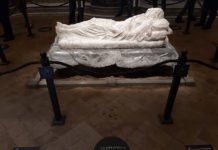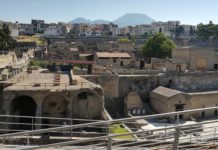We have seen them represented in the frescoes and bas-reliefs of the ruines. But even listed among the finds unearthed in the archaeological site of the world’s most famous and fascinating Pompeii. Now, the brainchild of Dieffe Communication, thanks to Molino Caputo and Paolo Gramaglia to the chef, the restaurant “President” of Pompeii, with the support of the bakery Esposito, the Bread of Pompeii will also be tasted. Thus was born the event “Molino Caputo presents Breads of Pompeii ” an attempt to bring the modern tourist, as much as possible, to the reproduction of the bread consumed by the ancient Romans. A journey through history, in fact. But also in the uses and in foods of ancient river town in which they lived about 10,000 inhabitants.
A population consists of different ethnic groups and a civilization in which flowed a variety of traditions. Pompeii before the eruption of AD 79, had 34 bakers equipped with ovens (the pistrina) and millstones of lava stone, some of them also provided to the shelves. About 5 of these were considered great bakers (up to 3 mills ), other, smaller, it had only one. The millstones were spun “by hand” , by slaves or donkeys. From literary sources and iconography (frescoes and bas-reliefs) and archaeological (charred loaves), you know that the most famous types of bread were 10 (and that is also produced dog biscuits), subject to a number of variants, which leading to the production of an unknown number of loaves. The first bread produced was the roughest and toughest.
Around the fifth century BC, came from Sicily and Africa, hard and soft grains of superior quality that enabled the production of breads and buns of excellent workmanship. The bread is diversifying in form, recipients, pastes and cooking methods. The most valuable was the panis siligineus, a white bread made with flour upper and intended to rich consumers. It was a circular loaf, on which were already drawn the lines to divide it into eight parts. The Romans did not use the knife to cut the bread, and so, out of the oven, it could already be divided among the guests. The panis artolaganus was, however, considered to be the bread of the holidays. With a very rich mixture that included the presence of vegetables, candies, honey, olive oil and wine.
Was also very rich adipatus panis, “stuffed”, as the name implies, with lard. A darker bread, for the working classes, was the panis cibarius, elongated (like “ciabatta”) and produced with a mix of flour of barley and spelled. Even more “essential” than the previous, the panis secundarius: also elongated and produced with whole wheat flour. Among the most common types also panis bucellatus, which provided a toasted bread baking followed by a “dry” in a hot oven. Very popular also the buns, similar to those we eat today, and seasoned with olive oil and rosemary and / or with olive oil and olives. Last but not least, the panis furfureus, a bread made with bran and intended for dogs.
The attention devoted to ancient Pompeii bakery is also demonstrated by the different cooking involved: as well as in the oven, the bread could be baked in the ashes, place on a conductor of heat source (for example, on an amphora heated followed by baking bread for induction). Or in a pot that at the time of serving, was en route to “liberate” the product.

 Italiano
Italiano














